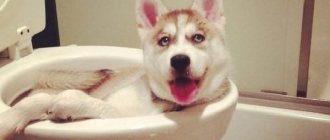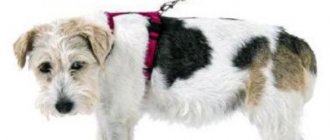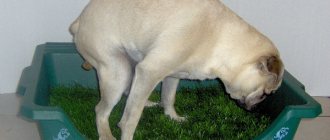Types of muzzles
Plastic
The model is made of plastic intertwined rods. The product is lightweight and quite durable.
After a walk, the plastic can be easily washed off from dirt. Due to the wide rods and the space free from the mouth (if the size is chosen correctly), the dog can easily open its mouth, which is very important for cooling the body in case of overheating.
The model will prevent the animal from trying to pick up something from the ground.
You should be careful when using a plastic product in winter, when exposed to frost: the material may crack.
The model is suitable for dogs of small, medium and large breeds.
Leather
The product consists of intertwined leather rods in the form of a mesh, which are secured to each other using metal inserts.
The model is predominantly light, due to which the dog is not only more comfortable using it, but also on walks, especially if the pet is not overly careful; in case the dog bumps into your legs or touches your legs with its muzzle, the product will not cause you additional pain.
In such equipment, the dog will not be able to pick up anything from the ground. The leather model is durable.
Such a thing requires some care, otherwise the model will become stiff and unusable.
Also, when washing leather, you will need to dry it, unlike plastic or metal materials, which can simply be wiped with a dry cloth.
The leather model is suitable for pets of large and medium breeds.
Metal
The model is made of iron intertwined rods in the form of a mesh.
This product is very durable. The dog will not be able to pick up anything from the ground wearing such equipment. Also, the animal can easily open its mouth, and in the heat it will not be difficult for it due to this.
The product is quite heavy, and therefore your pet can hurt you if it accidentally bumps into you and hits you with its muzzle.
After a walk, the metal can be easily washed and wiped with a rag. The model is suitable for dogs of large and medium breeds.
Fabric
The model is a sewn nylon fabric that fits tightly to the dog's face. The nose and the space around it remain open.
Fabric ammunition is very light.
Since the pet cannot open its mouth with this product, it is highly not recommended to use it in the heat or give the animal physical activity - this is fraught with bad consequences.
It will be difficult for your pet to pick something up from the ground, but it is possible. The dog can at least lick the edible food. Such ammunition is not durable. After walking and washing the product, you will have to dry it.
The model is suitable for dogs of small, large and medium breeds.
Halter
The model consists of several sewn fabric strips with a ring for attaching a leash.
Such ammunition is not suitable for aggressive dogs or animals that have problems picking up from the ground, since the pet will be able to easily move its mouth in it.
The halter is adapted to attach a leash to it; the dog, due to the design of the product, stops pulling and walks on a sagging leash.
The model is difficult to get dirty, but after a walk it can be washed with water and needs to be dried.
The halter is suitable for dogs of medium and large breeds.
What should you not do?
There are several common mistakes that almost all owners make.
- If you have already put a muzzle on your dog, and she is actively trying to remove it, you should not indulge her. In the future, she will know that the manifestation of dissatisfaction on her part will be a reason for action for you.
What to do:
Distract your dog. Switch your attention to the game, give the command “nearby”. She will forget about the uncomfortable accessory and stop struggling with it.
- Do not use the muzzle for procedures that are known to be unpleasant or exciting for the dog, such as vaccinations, veterinary appointments, or nail trimming.
What to do:
Instead of a muzzle, use elastic bandages or a special narrow muzzle that is different from the one the dog usually wears.
Before you start training your dog to wear a muzzle, be careful about the model you choose. The muzzle should not be too tight. For the hot season, it is better to choose the loosest possible options (for example, a cage muzzle), which will allow the dog to open its mouth and stick out its tongue. And remember: the main thing is patience and gradualness. Do not move on to a new stage of training if the previous one has not yet been fully mastered by the dog.
How to choose the right model
The pet supply market offers a wide range of products to suit every taste. For each pet, ammunition is selected individually, taking into account a variety of details: the size of the pet, the purpose of purchase (dog aggression, protection from being picked up from the ground, travel in public places, and so on), wear resistance.
- If your pet has aggression towards other animals or people, you should purchase a durable closed model that fits well on the animal's face. Metal, leather and plastic products are suitable.
- If your pet has problems picking up from the ground, closed models are suitable: plastic, leather or metal.
- If you need to purchase a muzzle in order for you and your dog to be allowed into public places and transport, you can purchase a halter. In fact, this thing is a muzzle, so you are not violating any prohibitions by using it. In addition, the pet will be comfortable in this accessory.
- For a trip to the veterinarian, you can purchase a nylon model. This item is not suitable for everyday use, but for such situations its use will come in handy.
Main stages of training
If a puppy is able to master wearing a muzzle in a week, then in the case of an adult pet, more patience will be required. This will take at least 3 weeks. The main stages of training an adult dog:
- Allow the dog to sniff the equipment and give him the opportunity to make sure that no threat comes from this item. As soon as the pet loses interest in it, give it a treat.
- Place a treat in the muzzle, allowing the dog to take it. He will inevitably have to stick his face inside. You cannot put on the accessory at this moment; you need to wait for the pet to free itself from it.
- As soon as the dog stays in the muzzle for 2 seconds, you need to give a treat. She is then given treats after certain periods of time while muzzled. Having discovered that this period is more than 7 seconds, you need to snap the clasp and immediately unfasten it. This maneuver is repeated several times until the dog begins to ignore the snapping of the buckle. After this, increase the period of wearing the ammunition, be sure to treat the pet and reward it for calm behavior.
- After the dog gets used to it, walks begin. The accessory is worn so that the pet does not experience discomfort. If you try to remove it during a walk, you need to actively distract the dog. It is advisable to walk in places unfamiliar to him, where there are enough distractions. Calm behavior must be rewarded with a treat. You can remove the muzzle only when the pet is distracted and stops paying attention to it. This should never be done if the dog is trying to remove it on his own.
To prevent the animal from having a negative association that arises when putting on an accessory, it is put on in advance before unpleasant procedures. After the procedure, praise the pet and reward it with a treat.
How to determine the correct muzzle size
The easiest way would be to bring your dog to a pet store and try on the product there. The muzzle should be tightly fixed on the animal's face, but should not leave marks on the animal from the straps and rods after use.
If we are talking about plastic, metal or leather models, the dog in such a product should have free space around its mouth so that it can breathe calmly by sticking out its tongue.
The main thing is that the ammunition does not cause discomfort to the animal.
Optimal age for accustoming to equipment
Some experts believe that accustoming a puppy to equipment should take place in the first months after birth. In their opinion, the adaptation process will be much more successful and will not cause rejection in the pet. Although it is unlikely that a puppy under the age of 2-3 months will understand what they want from him. There are enough videos on the Internet that can help you understand the principle of training a growing dog.
How to accustom a puppy to a muzzle, and at what age should this begin? The optimal age is considered to be 5 months. If the puppy is sent to a general training course, which includes accustoming to equipment, then the optimal age is considered to be 6-7 months.
If a pet “comes” to the house and is not accustomed to this thing, it is quite possible to accustom the dog to a muzzle, but this may require a little more time and patience. If the question arises about how to train an adult dog to wear a much-needed muzzle, you can watch many videos with experienced trainers.
What dog breeds need a muzzle?
Large and massive breeds of dogs need a durable model; pets of small and medium breeds can purchase a simpler product.
A muzzle is needed, first of all, for aggressive animals to protect others and for dogs that like to pick up from the ground, to protect the animals themselves.
The need to use the product does not depend on the breed of the animal.
At what age should you start teaching
It is best to start accustoming your dog to a muzzle, as well as to many other things that are not very pleasant for some animals, such as bathing or ear cleaning, from an early age. It is easier to accustom a puppy to something new and he will not experience as much stress as dogs do in adulthood.
Large breed puppies begin to be trained at 5-6 months, and small breed puppies at 7-8 months. Of course, every month the pet will grow and over time you will have to buy a new accessory, but the learning process for puppies takes much less time. An adult pet can also be trained, but this will require more time and effort.
Stages of training a puppy or adult dog to use a muzzle
- Take a treat and show it to your pet. Place the muzzle on the animal's face without putting it on the dog, and give the pet a treat. Repeat this several times.
- Present the product so that it covers a small part of the animal's muzzle, then praise the dog. Repeat several times.
- Place the harness on half of the animal's muzzle, then give the dog a treat. Next, you can hold the muzzle in this position for a few seconds. Don't forget to praise the animal.
- Place the muzzle completely on the animal's face without fastening the fastening straps, and then give the pet a treat. Repeat this several times, and then begin to hold the product on the animal’s face for a few seconds.
- Place the product completely on your dog, fastening all the fastening straps. After a few seconds, remove the muzzle and give your pet a treat. Repeat this several times.
- Increase the amount of time your pet is muzzled. You can give your pet treats without removing the product through the hole in the muzzle.
- During walks, if the dog does not try to remove the equipment, periodically praise the animal with a treat.
Stages of training
Developing correct conditioned reflexes is a prerequisite for successful learning. The dog should imagine that only pleasant events are associated with the muzzle (at least during habituation).
- Acquaintance. We introduce the animal to the muzzle. Let's take a good look and smell. Gnawing, chewing, playing is not allowed! We place a treat in the muzzle and treat the dog so that he can get something tasty only by putting the mod inside. Attempts to pull out a piece from the side or obtain it in another way should be stopped. The prize goes only to the one who sticks his nose into an unfamiliar thing. At this stage, do not fasten the muzzle and do not try to extend the time spent in it; this is only the first acquaintance.
- We increase the stay time. We continue to treat the dog from the muzzle, trying to extend the time of stay - for example, we feed the first piece of treat from the muzzle, and the second through the muzzle from the outside. This way, the muzzle will remain on the dog while it pleases itself with a treat. Later, you can leave only the second part of the procedure - putting on a muzzle and then giving a treat. We gradually increase the interval between putting on the muzzle and receiving the reward.
- Walking in a muzzle. A muzzle is not only goodies, but also entertainment. When the dog can stay in the muzzle for at least a short time, we begin to put it on when going for a walk. At first, you can remove an accessory that is unusual for you almost immediately, for example, when you go out into the yard. Gradually increase intervals.
- Consolidation. Consolidation of the skill, a long stay (the entire walk) in a muzzle. If the dog tries to remove the accessory, distract it with a toy, running, or the command “near” (if by this time the animal is firmly accustomed to this command, it understands that “near” implies ignoring extraneous stimuli, including strangers, cats, etc. of course, a muzzle).
Common mistakes
- Forcibly pushing an animal's muzzle into a muzzle . In order for the dog to have a positive attitude towards the product, only with the help of a treat force it to pull its muzzle into it. Under no circumstances should you put on a muzzle against the will of the animal, otherwise in the future the pet will resist the product even more.
- Abrupt transitions from stage to stage . Accustom the animal to the muzzle smoothly and carefully. You should not rush in this matter if you do not want the dog to resist the ammunition.
- Rare reward with a treat . The pet should associate the muzzle in his head with something pleasant. To do this, reward your dog a little, but often. Try to give your dog treats directly through the muzzle.
- Punishing a pet for trying to remove ammunition . If you punish your pet for trying to remove the product, the dog will treat it even more negatively than before. In addition, your contact with the dog will deteriorate. Try to correct the problem exclusively through a positive impact on the animal.
Muzzle training: don't forget about safety
In the first stages of training a dog to wear a muzzle, the owner needs to be prepared for the fact that the pet will show concern or even aggression, which can cause harm to both itself and others. The training should be carried out by the dog's owner or an experienced specialist, that is, a person whom the dog treats with respect and trust. You should not delegate the task of training an animal to a muzzle to children - this can result in bites or other troubles, especially if we are talking about adult dogs of large or fighting breeds.
If violence is used, the dog may become aggressive
For training, it is better to choose a fairly light model made of nylon or leather - a metal collar is not suitable for these purposes. When a head strike occurs, it causes damage to both the target and the dog itself, causing the dog to associate the muzzle with pain or discomfort. For the same reason, you should not let your pet scratch its face in an attempt to remove the product from its head.
After the animal has been in the muzzle for several minutes, you need to carefully examine its head for any chafed, reddened or depressed areas - their presence indicates that the model is too small and will cause serious discomfort if used regularly.
Examination of the dog's head after trying on the collar
What to do if your dog removes his muzzle on his own
If the dog removes his ammunition:
- adjust it and make it tighter;
- wait until the animal stops removing the product for at least a few seconds, then praise the pet with a treat;
- repeat several times.
If your pet does not remove the muzzle, remove it yourself and give the animal a treat, then put the product back on and continue to praise the animal with treats when he does not try to remove the equipment.
In the future, the dog will understand that removing the muzzle will lead to nothing, and the owner will treat him with a treat for being in a calm state.
Let's start training
There are several methods. We recommend starting with the first one, as it is simpler and more gentle. Owners move on to the second one after 3 weeks if there is no progress. Let's consider both methods.
Simplified lessons
Start with an introduction, with a muzzle. Let your pet sniff the new item and leave it on the floor for a while. The puppy may think it's a new toy. Stop any attempts to chew or have fun with a prohibiting command.
For a few days, simply show the muzzle before feeding, walking, playing, etc. Soon the animal will understand that the accessory is associated with something positive and will begin to perceive it positively. It is advisable to take “clothes” with you on a walk.
After the initial habituation, you can move on to basic training. First, fasten the buckles around your companion's neck. Most likely, your pet will protest, but will quickly come to terms with it - the new product looks like a collar, nothing scary. Do your best to distract the dog so that it does not concentrate on the sensations. Take your favorite toy or engage in training, praise and pet often. Contact with the owner is very important.
The next stage is wearing a muzzle around the neck while walking. Usually this step causes fewer difficulties, since the pet is involuntarily distracted outside. After a positive reaction, try dressing your dog at home. First, hold the straps loose, do not fasten them.
Full donning should be accompanied by games, training, or just praise. The second is preferable, since a muzzle develops discipline. In addition, the dog will clearly know that at the end of the training he will always be praised, given a treat and the accessory removed. When the animal can calmly withstand indoor exercises, move to the street. This completes the process.
Most of the problems are due to the haste of the owners. How do you know if your dog is ready for the next stage of training? If the animal is happy and wags its tail at the sight of the muzzle, you can safely proceed to the new stage.
Advanced course
Does your pet resist and protest in every possible way? Believe me, you are not alone. This problem can be dealt with with cunning. The learning process is generally the same, but before tightening the straps, start using the muzzle as a bowl. Leave the treat in the “clothes” so that your pet can see. Let me eat. After some time, the animal will get used to the sensations.
Now try putting on the straps. The scheme is the same - hold the relaxed belts for a few seconds, then release and praise. If your pet behaves calmly, you can give him a treat. Gradually increase the duration of your workouts. Next, fasten the buckle loosely enough and offer the dog a treat, pushing it through the muzzle.
You should soon progress to going outside in your “clothes.” Do this also step by step: first, walk on the leash only to the door and remove the accessory, then increase the distance. Later you can tighten the buckle more tightly.
It is important to give your pet enough attention at all stages and approve of good behavior. The bad should simply be ignored.
Briefly about the main thing
- The pet products market offers a wide range of products made from various materials: plastic, metal, leather, fabric (nylon), muzzles and halters.
- In order to protect others or the pet itself from being picked up on the street, it is recommended to choose durable products that completely cover the mouth. Leather, metal or plastic models are suitable.
- If you need equipment for visits to the veterinarian, you should purchase a cloth muzzle.
- To be with your pet in a public place or transport, you can safely purchase a halter.
- In order not to make a mistake with the size of your purchase, you should come to the pet store with your pet and try on the item directly there. The product should be tightly fixed on the animal’s face, but it is necessary that the dog has space around its mouth so that it can breathe freely with its mouth slightly open.
- The animal must be accustomed to equipment from any age. The earlier the better.
- You need to accustom your pet to the product smoothly and carefully, with the help of treats. First, present the item to the animal's face, then bring the item closer and closer, eventually finally placing it on the pet's face. All actions should be supported by a treat. Remove the product only when the dog is calm. If your pet tries to remove the muzzle, wait until he stops doing so, then give the animal a treat. Associate the pet's product with a positive thing.
We hope that the article was useful to you and that you learned a lot of useful information regarding muzzles. We wish you good luck in choosing and using ammunition for your four-legged friend!
First meeting
Having come from the store and unpacked the purchase, they invite the animal to sniff it. Then, carefully, without putting the muzzle on completely, fasten it around the dog’s neck, allowing it to walk around the apartment in this form for 10–15 minutes.
A positive reaction to a muzzle can be developed by throwing a piece of treat into it. Having eaten it from such an unusual “bowl”, after a few sessions the dog begins to joyfully wave its tail at the sight of the accessory. When going for a walk, it is recommended to carry the ammunition in your hand for the first time, without allowing your pet to play with it.
Large breeds are muzzle trained at 6 months. It is necessary that wearing it be associated only with positive and joyful emotions. The pet quickly understands that this is a temporary measure, after which a reward awaits him. You need to praise and treat your puppy every time he successfully completes a task. If you fail, we simply ignore it. During the period of accustoming to a muzzle, you should not allow it to be used when visiting a veterinarian or performing any procedures that cause discomfort or pain.
Errors in training
The most common mistakes inexperienced dog breeders make in muzzle training are as follows:
- buying an accessory that is too small or large, causing discomfort for the dog;
- the muzzle is worn before procedures that cause stress in the dog;
- removing the product at the moment when the pet tries to do it on its own;
- transition to the next stage of training without sufficient development of the previous one.
Finally, I would like to say that retraining a pet to wear a muzzle is much more difficult than immediately developing the correct attitude towards it. The owner must stock up on patience and treats, otherwise the learning process will be fraught with misunderstanding and stubbornness on the part of the dog. Be consistent, and after 2-3 weeks the dog will begin to perceive the muzzle as a granted addition to the walk.











